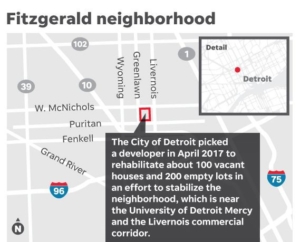Have you ever heard of Detroit’s Fitzgerald neighborhood?
If not, you will probably be hearing about it soon. It is a neighborhood that I had the privilege to get to know through our most recent Challenge project. Once known for its popular “Avenue of Fashion” and for housing both the University of Detroit Mercy and Marygrove College, we quickly learned that it is also one of the Detroit neighborhoods that has suffered from economic hardship, disinvestment and insufficient support for its neighborhood services; But, there is much more to this neighborhood than this piece of surface level knowledge.

A Map of the Fitzgerald Neighborhood Location.
(Photo: Detroit Free Press)
Despite these hardships, the residents of Fitzgerald have outstandingly preserved and strengthened in community. Fitzgerald is full of long-time Detroiters that never left when everyone else did, and they have been the ones who worked to maintain both the physical space and the strength of the community here. Now, Fitzgerald has been designated by the City of Detroit as the pilot neighborhood (outside of the downtown/midtown area) for the city’s first of its strategic neighborhood interventions and redevelopment focus.

A Mural in the Fitzgerald Neighborhood.
(Photo: Chelsea Coss, Challenge Detroit Fellow)

Mayor Mike Duggan in April 2017 leads the announcement of the Fitzgerald neighborhood project.
(Photo: John Gallagher, Detroit Free Press)
This most recent Challenge project was in partnership with Century Forward, a 501(c)(3) non-profit that was established in affiliation with the Fitz Forward Redevelopment Project. Their mission is “to provide a comprehensive array of resources to residents of Detroit’s neighborhoods to facilitate stronger, more interconnected communities.” https://www.centuryforward.org/mission
During this challenge, the fellows were tasked with answering the following question:
“How might we improve the quality of life in the Fitzgerald neighborhood by increasing access to resources that support economic sustainability?”
Solutions around this question included recommendations for: implementing a resident neighborhood association, a neighborhood communication strategy, community partnerships suggestions, utilities help and home improvement, improving economic security and increasing access to goods and services.
Every Challenge project includes community interviews as part of the empathy stage in our human-centered design process. It was during these community interviews that I gained a true sense of what it means to be a Fitzgerald resident, was introduced to my new apartment, and then became a resident myself! I can now officially thank one of our interviewees, (a teacher and an organizer of the college core block club in Fitzgerald who will remain unnamed for privacy reasons), for sharing her neighborhood wisdom and enthusiasm with us, and for connecting me to the landlord of the beautiful apartment she and her husband happened to be moving out of.

One of my team’s community interviews.
(Photo: Chelsea Coss, Challenge Detroit Fellow)
Although it was not a goal of the project or in any way expected, serendipity enabled me to find a new place to live through the connections and relationships that were built through this project. It is funny how life works out sometimes; I had felt so overwhelmed by the possibilities and logistics of deciding where to live in Detroit until this project came along and everything fell into place. Now, I couldn’t be happier to be part of the Fitz community and to call Fitzgerald my new home.
Interested to know more about the Fitz Forward project? Click these links for more info!
